All of a sudden, content marketing feels like the wild, wild west.
We’ve been watching the sands shift beneath content marketing for almost a decade. As times changed, so have our strategies — but this time, it’s seismic.
The SEO-reliant content marketing playbook that fueled growth for a decade has gone through the shredder. Search engines surface AI summaries instead of your hard work, and the clicks that drove your funnel are diminishing. Your marketing leader is running on fumes, and your content team has never felt more under siege.
Meanwhile, generative AI has enabled the creation of oceans of commodity content, leaving content marketers struggling to break through the noise.
Everything you thought you knew about SEO-led content marketing is old news. Here’s how we got here, and what you should do next.
The Collapse of Content Marketing as We Know It
For years, content marketing was all about volume — cranking out posts to drive traffic and bring in a steady stream of leads.
But that was yesterday’s strategy. AI has changed the game for good.
- Shifting behavior has crushed clickthroughs. Only 40% of Google searches end in a click to an organic result, with nearly 60% resulting in a zero-click search.1
- AI has eaten SEO content’s lunch. Only 8% of searchers click on a traditional search result when there is an AI summary.2
- This isn’t a blip, it’s the new normal. AI summaries are growing more prevalent all the time: Google’s AI overviews appear in 13% of desktop searches in March 2025, a 102% increase in just two months.3
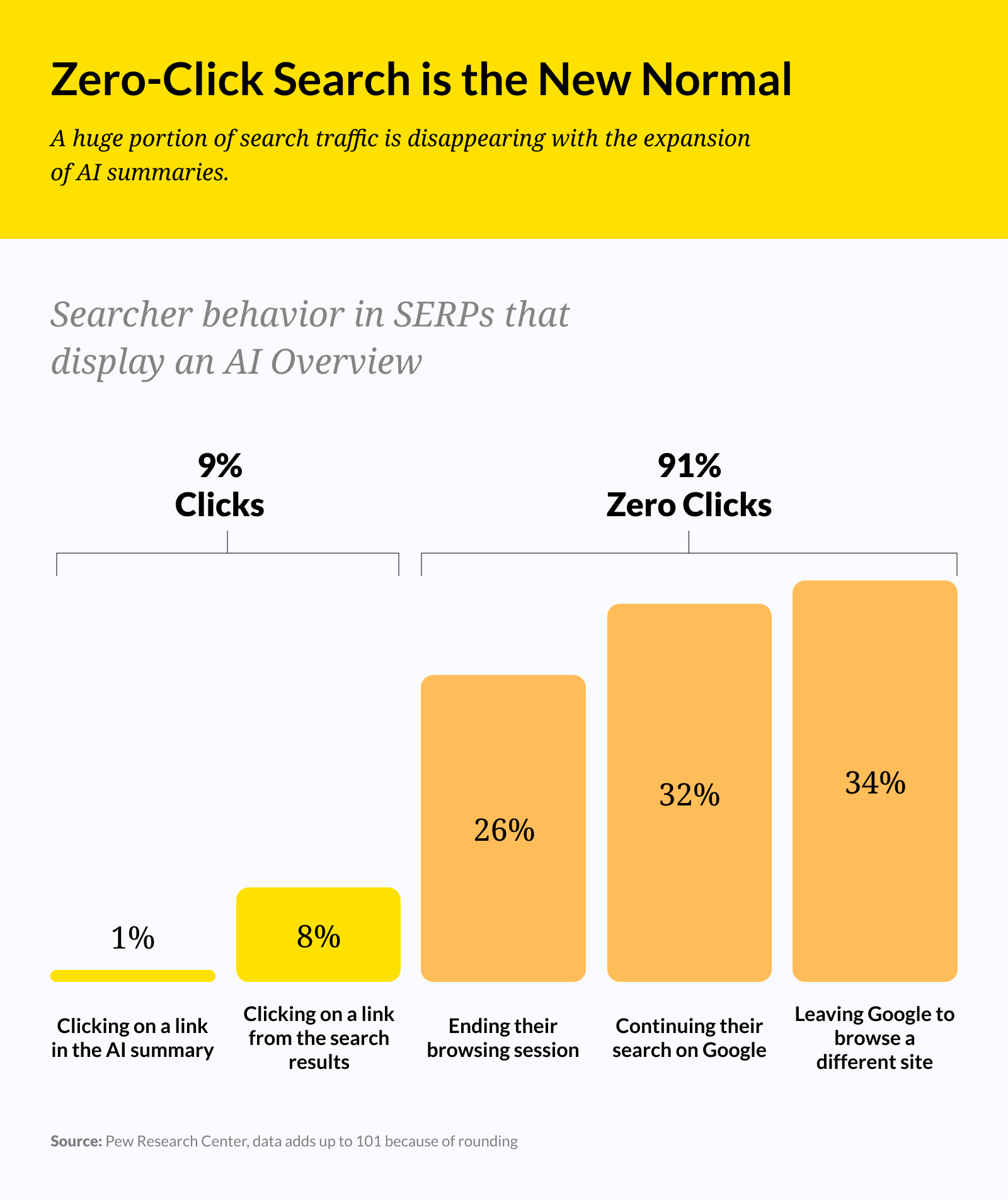
How did we get here?
We subscribed to the Content Factory Model, which was built on a simple, but ultimately flawed, premise: more is better.
The Great SEO Land-Grab Driving the Content Factory
In an era dominated by SEO, content was used as the raw material to manufacture attention, authority, and revenue.
The strategy was governed by two main rules.
Consensus content = higher rankings
Search algorithms rewarded high-authority domains that published content that generally matched the consensus on a given topic. Creating content that mirrored the market’s prevailing thoughts or ideas was a winning strategy.
More content + higher rankings = more traffic
Each new page of content was an opportunity to rank for more keywords and capture more traffic.
And so content marketers en masse wrote for the same keywords — guided by Google’s algorithmic preferences for topics, themes, and content structure.
The SEO land-grab strategy worked for a while, but even before the disruption from AI, marketers soon found themselves on a content treadmill. There were always new keywords to rank for or better positions to secure over competitors.
Content output became an essential KPI, often at the expense of quality or strategic impact.
This era was marked by what we call The Content Factory Model.
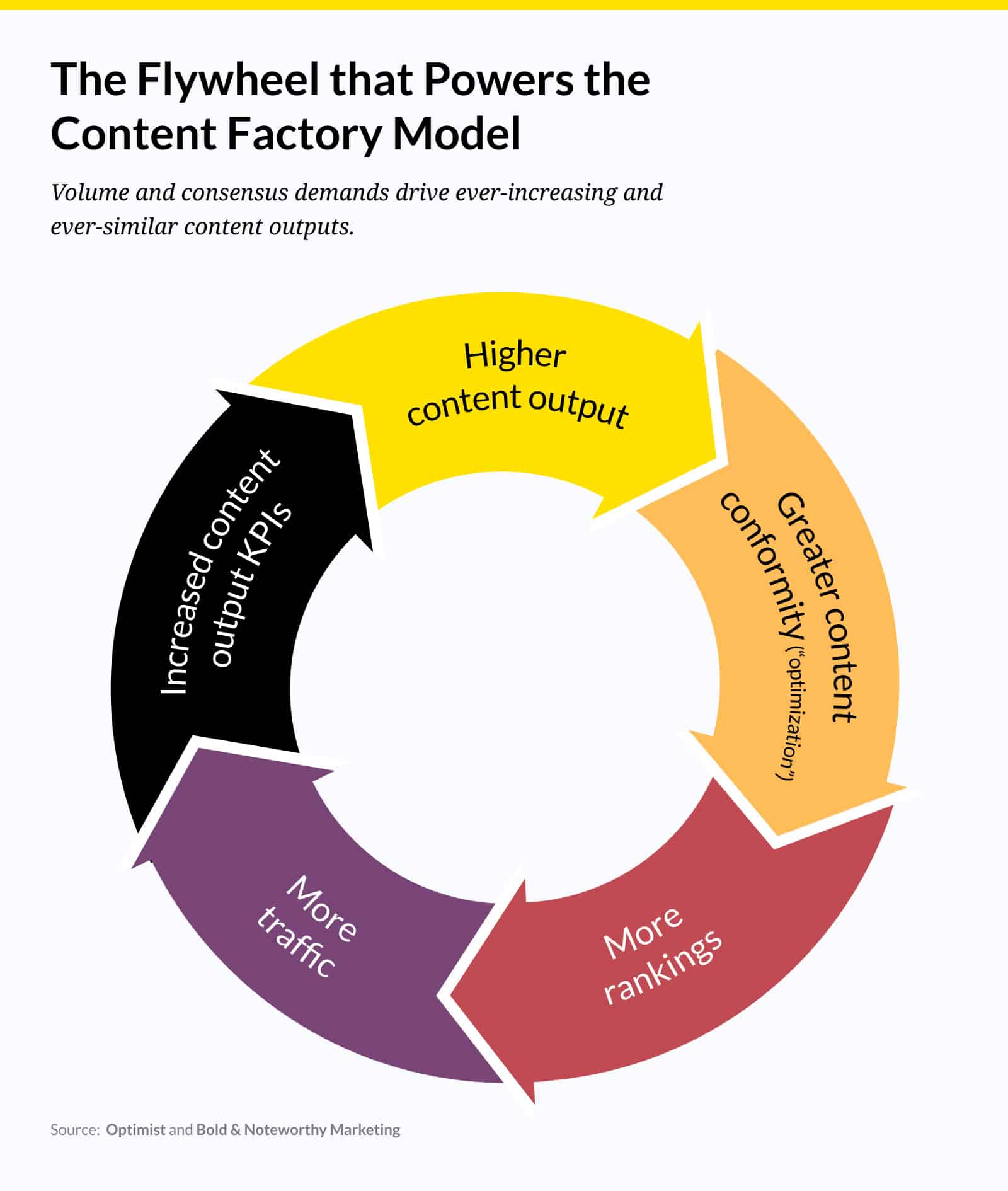
Trapped in the Content Factory
Because of the relentless pressure to produce more content and drive ever higher rankings and traffic, most teams found themselves focused on constantly churning out new blogs and articles to meet demands and quotas.
The Content Factory Model turns content teams into a service desk for the rest of the company:
- Your SEO team delivers lists of keywords to target.
- Your marketing VP sees traffic increase, and asks you to scale production.
- You, the strategic content leader, are forced to put your vision aside and act as project manager for a rapidly growing content engine.
“Every single team I’ve ever joined is always reactive […] They’re just creating whatever everyone else in the organization says they should create.”
—Chelsea Castle, Head of Content and Brand, Close 4
Suddenly, your Asana board is overflowing with requests. You’re no longer shaping a brand narrative and content themes; you’re managing a production queue, fulfilling requests with little room for strategic input or creative vision. Team morale is in freefall, and you’re headed towards burnout.
Let’s be honest, we all played the game. The Content Factory Model is exhausting and relentless, but SEO content used to deliver predictable results. We only needed to follow a simple formula to see higher traffic.
And so, we trudged on. Even when we saw cracks forming, we focused on making the charts continue to go up. Our work felt valuable, even if we knew it wasn’t the most efficient or fulfilling.
Then things changed — dramatically.
The rise of generative AI turned the Content Factory Model from inefficient to obsolete.
Ranking in search is no longer a reliable driver of traffic. And traffic is no longer a reliable source of audience attention.
The fundamental exchange of value we were chasing with our content factories is now broken.

Even true giants of content marketing have been forced to pivot. For years, HubSpot set the standard other content marketers followed. But when no-click searches caused their own traffic to plummet, they accelerated changes to their strategy — focusing on influence, rather than just information.5
How AI Doomed the Content Factory
4.6 billion pieces of content are produced every day.6 Most of it is “commodity content” — repetitive, information-based, low-value articles that flood search results. They have no unique brand identity, inspire no loyalty, and compete primarily on availability, not value.
It’s the content that Google demanded, but it lacks any brand differentiation and any unique or insightful perspective. And now, the creation of commodity content has been supercharged by generative AI — making the game unwinnable.
By betting hard on SEO, we thought we were building engines of growth. Instead, we built factories churning out commodity content. It’s a race to the bottom and AI just dealt the final blow.
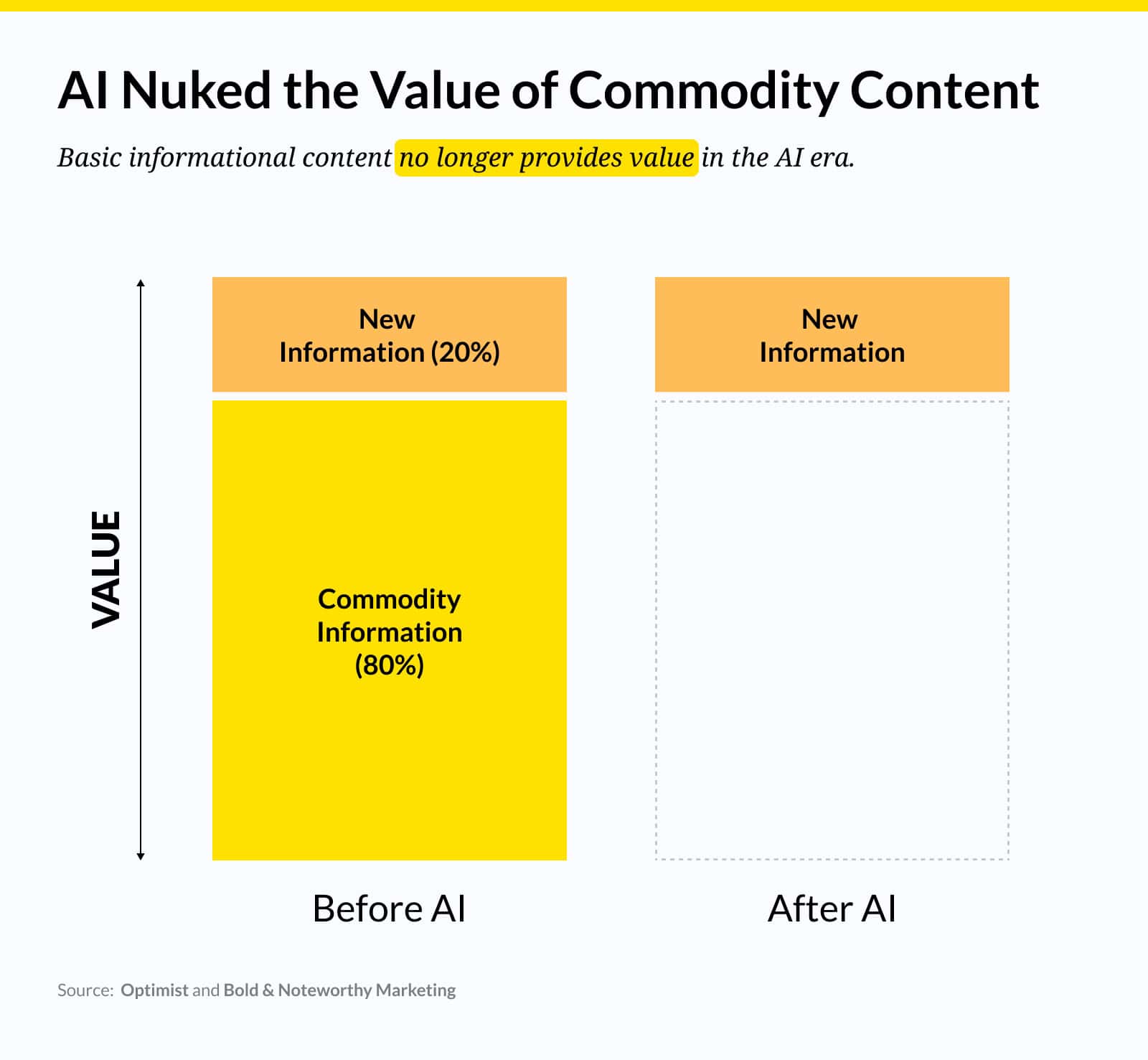
The Strategy Vacuum: What’s Left After AI Breaks Search
So what happens now that creating commodity content at scale no longer drives reliable website traffic?
Many content teams don’t have an answer to that question. Under pressure to deliver consistent growth, we relied on SEO as a stand-in for strategy. Without it, we’re adrift without a North Star.
Nearly 43% of content marketers cite lack of strategy as a core non-content creation challenge.
—The State of Dis(Content), The Content Studio, October 2024 7
Welcome to the Strategy Vacuum — the void left by changing algorithms and SEO’s new rules of engagement, plus a lack of a clear point of view or narrative to guide strategic content creation.
Here’s what happens in the absence of a true strategy:
- Competitors take the lead. While you’re still creating content for search engines, competitors are outpacing you with sharper insights that impact the buyer’s journey.
- Your team is under the magnifying glass. Execs begin asking: “Why do they own this conversation and we don’t?” They look to content leaders for answers — not the teams that consumed your time with non-strategic requests.
- Execs question the value of content. Why fund a strategic content leader when all you need is a project manager to farm out production? They may even have latched onto AI as a potential solution.
“The future of content is no longer just about clicks — it’s about creating connections that resonate, engage, and endure.”
—Fajr Muhammad, VP of Content Strategy & Growth, iPullRank 8
Operating in a Strategy Vacuum, your content makes no lasting brand impression and cedes thought leadership to competitors. This directly undermines core business goals like becoming a market leader, building brand authority, driving sustainable revenue, and creating customer loyalty.
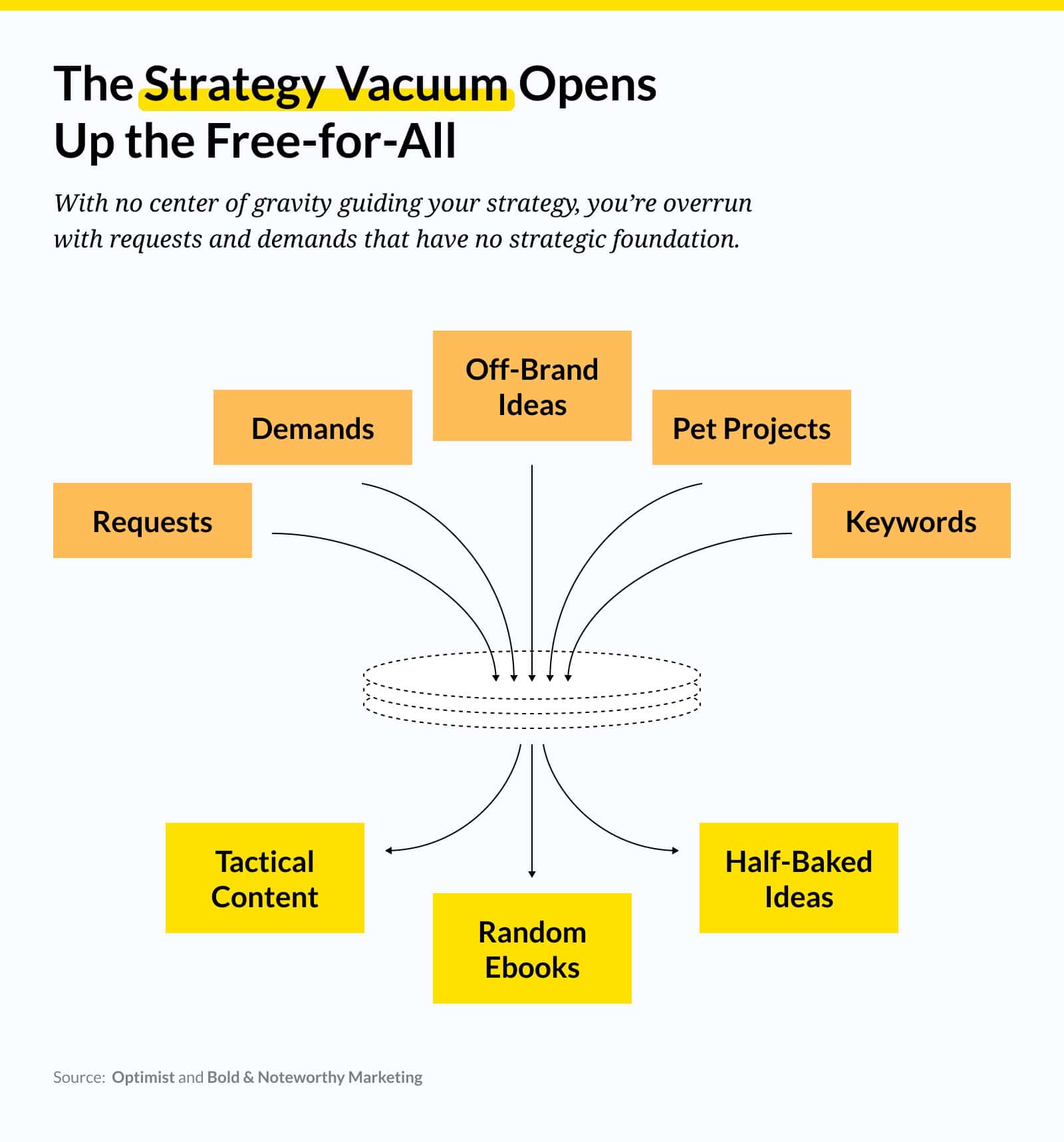
And you feel it daily, with nothing anchoring the strategy, as your team is pulled from priority to priority. Your role seems relegated to fulfilling the whims of every other team rather than setting any kind of clear vision for what content should look like and how it should drive value for the business.
The new era of content marketing demands a fresh approach. It’s time for change.
The Authority Moat Model: Your Ticket Out of the Content Factory & the Strategy Vacuum
We’re at a critical juncture — everyone feels it. AI has triggered a turning point for content marketing.
The SEO industry is telling you how to get cited in LLMs. Google is telling you to demonstrate E-E-A-T. Meanwhile, you want a stronger voice at the table, sharing the strategy and guiding the narrative that will engage your audience and inspire them to take action — not just get them to a landing page.
“The value in content marketing? Ideas. Insight. Point of View. Storytelling.”
—Tyler Hakes, Principal & Strategy Director, Optimist
In this era, the brands dominating content marketing are the ones shifting from volume to value.
- They focus on proprietary ideas that establish and communicate their brand’s unique perspective.
- Their content differentiates them from competitors with a unique ideology that provides clarity and confidence for their customers and prospects.
- Content leads buyers to a singular solution – yours. It’s not plug-and-play content that could live on any brand’s domain. It’s uniquely tied to your business and works to establish and defend your unique segment of the market.
With these goals in mind, they build their content marketing strategy on the basis of three key foundations:
- Transformative Point of View: A unique, compelling, and consistent perspective that offers Radical Clarity for your audience and guides them to your singular solution for their most pressing problems.
- Cohesive Content Library: Each content asset should reinforce your POV, forming an ecosystem of ideas that help your audience achieve their goals more effectively — and generate a consistent pipeline of qualified leads.
- Top-Down Strategy: An unwavering strategy built on the narrative foundation of your Transformative POV. The overarching narrative clearly defines your “North Star” and prevents you from taking detours into “random acts of marketing”.
This approach gives you the direction and clarity you need to create a library of proprietary content assets that AI, competitors, or other shifts in the marketing landscape can’t replace.
We call this The Authority Moat Model.
“The companies that broke through didn’t start with tactics or even traditional strategy. They started with a story: a clear explanation of what was changing in the market, and why their product existed because of it.
Your job as a marketing leader is to define that kind of narrative, and then continuously reinforce it. What’s changing for your customer? What shift are they trying to navigate? And how does your product help them respond?”
—David Gerhardt, founder of Exit Five and former head of marketing at Drift21
Your Authority Moat is a comprehensive strategic approach to content marketing. It’s how you build a story that can’t easily be replicated — and trust that can’t be undercut by your competitors.
Content becomes a competitive moat for the business.
Your story drives differentiation. And each asset works together to build compounding returns in affinity, demand, and revenue.
It’s the kind of work content marketers have wanted to do all along: unshackling themselves from the content treadmill and delivering real business impact.
“Brands that are leaders of good ideas, new insights, and expert opinions produce distinct, differentiated content with thoughts so refreshing that your audience naturally pays attention and engages. The ideas you offer them change the way they think. That’s how you connect and build relationships with audiences in this era of information overload.”
–Kristen Rocco, Fractional Content Marketing Leader & Founder, Bold & Noteworthy Marketing
| Content Factory (The Old Way) | The Authority Moat Model (The New Way) | |
|---|---|---|
| Defining Characteristic | Interchangeable and disposable. | Unique and defensible. |
| Primary Goal | Land grab. | Ideological resonance. |
| Source of Value | Volume and velocity. | Transformative POV. |
| Business Impact | Traffic, engagement. | Market transformation. |
| Audience Reaction | “I’ve read this before.” | “I’ve never thought of it that way before.” |
Authority Moat in Practice: Basecamp Rewrites the Rules of Work
Basecamp is a prime example of the Authority Moat in action. Over the years, they’ve developed and marketed multiple Transformative POVs and proprietary models that changed the conversation about how work should be done.
In 2024, they posted an estimated $66M profit—with just 80 employees.11
This makes them one of the most profitable companies in the work management space, outperforming massive brands like Monday.com, ClickUp, and Asana.
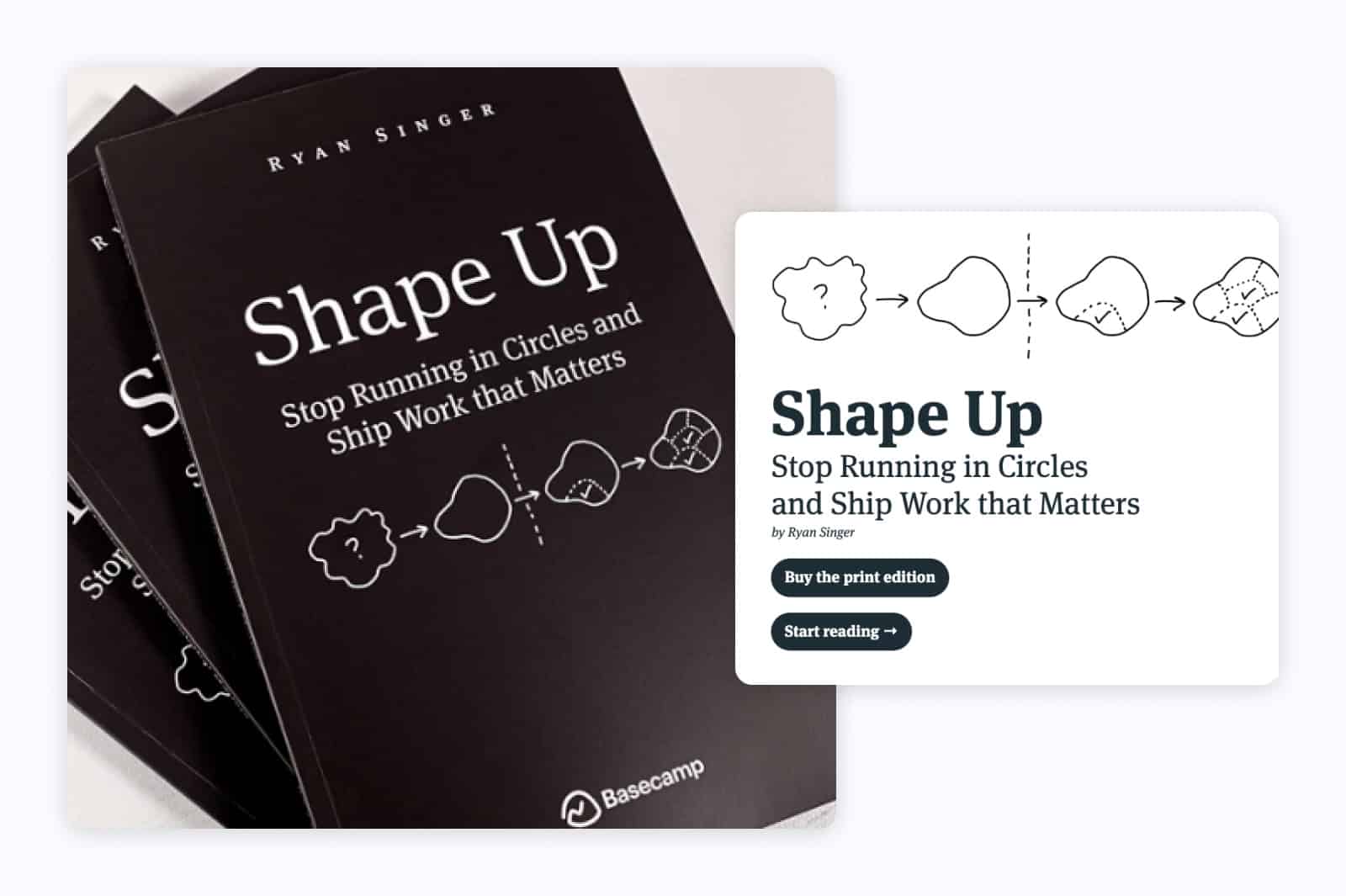
And they’ve used that approach to build a massive audience of devoted fans and customers.
With Rework (the manifesto-turned-book), they tore up conventional wisdom about work — arguing for simplicity, autonomy, and focus. With Shape Up, they took a contrarian stance against Agile frameworks, which are supposed to make teams work smarter, but often leave them burned out.
But they didn’t just rail against conventional wisdom. They put forth a new narrative – a new way of thinking about these problems and a new path toward solving them.
All of this helped Basecamp find a fanatical base of loyal customers in the incredibly crowded market of project and work management software. They carved out their ideological space and built a fortified market position – their narrative is their competitive moat.
The Authority Moat Methodology: How to Turn Content Into a Competitive Moat
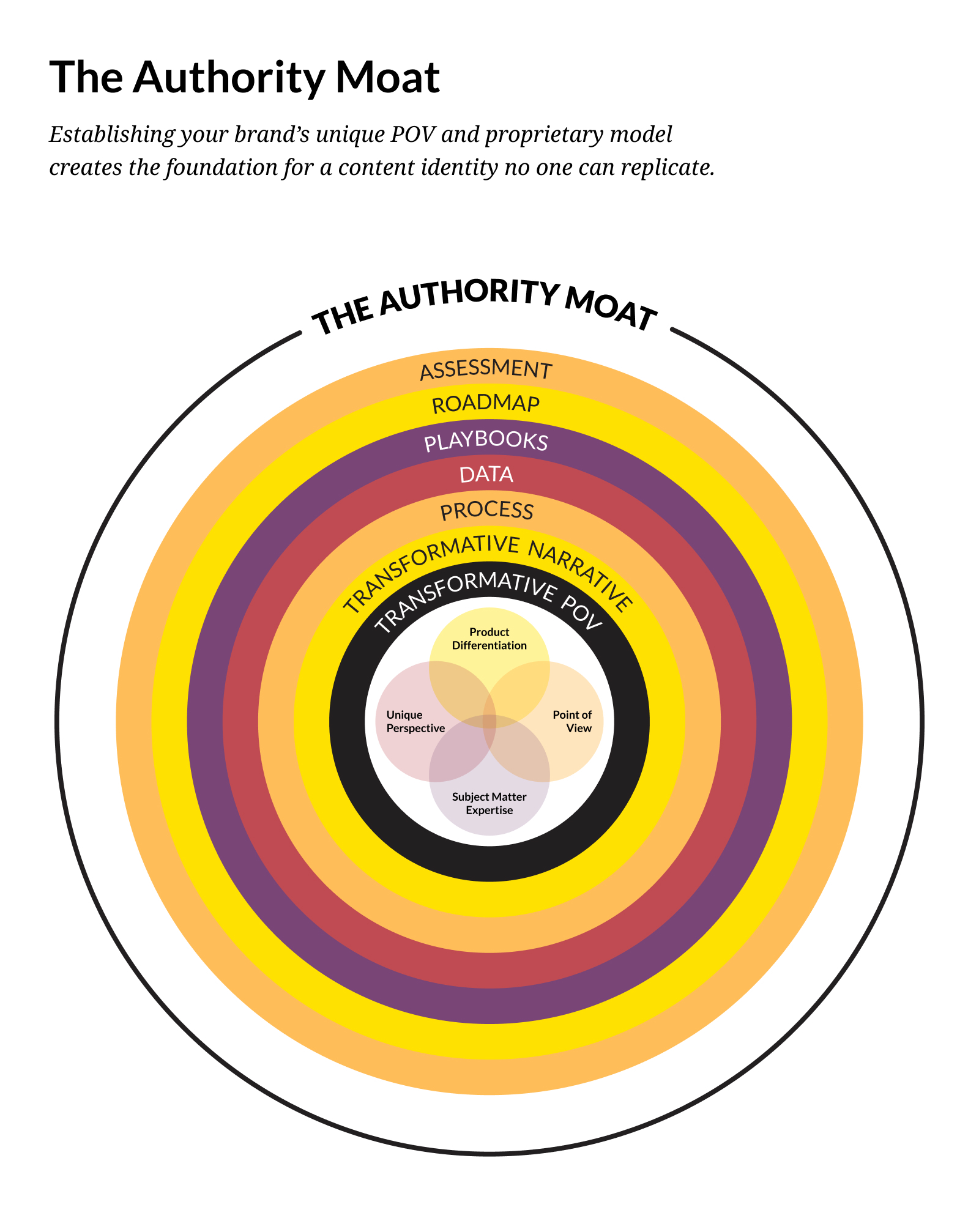
We studied brands like Basecamp, Gong, and Drift to understand the exact process they used to distill their story down into a clear and coherent set of messages and beliefs.
We identified many common factors among these brands and others who have successfully established a narrative identity that became a competitive moat for their business:
- Planting a flag. Each company took a strong and principled stance. At a time when hustle culture and enterprise process bloat are rife, Basecamp challenges both — speaking directly to small businesses and fast-paced startups who are losing faith in the old ways.
- Bigger than a framework. They radically rethink how customers should think about and solve their problems. Rework and Shape Up are more than talking points or best practices; they are a call to arms — embedding Basecamp’s own philosophy into ideas people can live by.
- Expanding their Authority Moat. By anchoring their proprietary models in a consistent philosophy, these companies create a ripple effect: widening their Authority Moat, growing their community, and extending their influence.
We distilled these findings and more into a process for defining and defending a unique market message. We call this process The Authority Moat Methodology.
Now let’s explore how this approach works in practice.
1. Define Your Transformative POV
You build an Authority Moat by strategically developing and deploying a Transformative Point of View (Transformative POV).
Transformative POV is the singular perspective that forms the foundation of your Authority Moat.
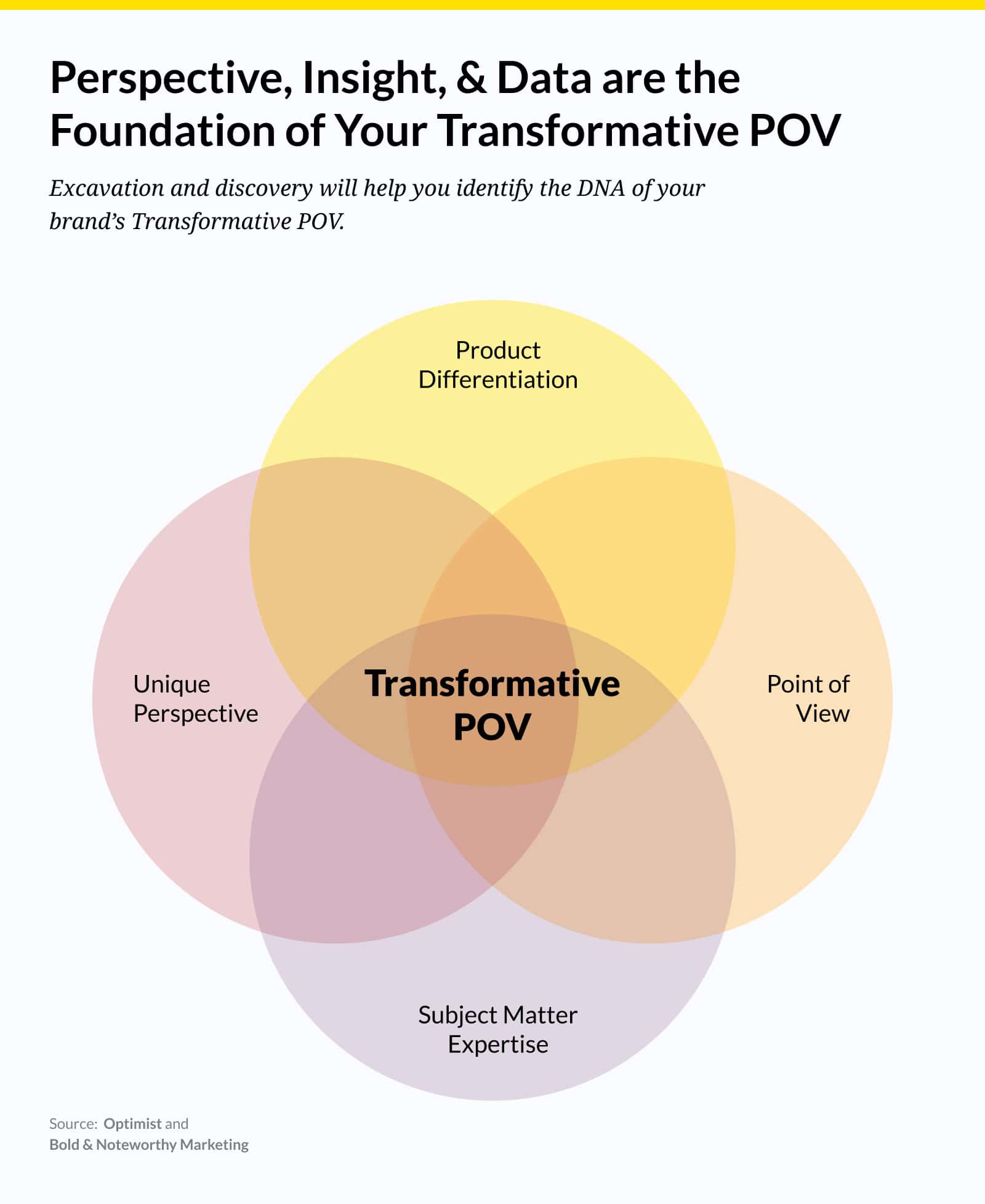
Your Transformative POV comes from an internal inventory of your brand’s unique perspectives and an exploration of your audience’s most pressing problems.
You derive it from an excavation process of your subject matter expertise, a founding principle behind your business, or an unconventional view that’s widely held by your team.
For example, the Transformative POV at the center of Basecamp’s Rework is deceptively simple, but ultimately profound.
We might summarize it as something like:
Small, focused, and fast can beat big, rich, and methodical.
But, of course they didn’t arrive at this thought on a whim. It came directly from the founders and their real-world experiences, thoughts, and feelings about business.
Your brand has similar ideas.
They might be floating around in the CEO’s head or proven out in the data that only your company owns.
There is a breakthrough idea at the center of your business, just waiting to be surfaced and turned into an Authority Moat. Your first job is to find it through a deep exploration into what makes your brand unique and what message will set you apart from all the others in your market.
Excavation
Begin with an internal inventory of content and context you can use to shape your Transformative POV.
Anything that can inform your unique perspective or provide market and audience insight. Think subject matter experts, customer persona documentation, proprietary data.
Discovery
Gather a working group to unpack the ingredients you discovered.
Dig into the underlying problems and pain points they can address for your buyers. Your goal is to develop a conceptual model that places your unique solution at the center of pressing and emerging customer needs.
2. Write Your Transformation Narrative
Once you have a working Transformative POV, the next stage is to turn that idea into a story that resonates with your audience.
We call this the Transformation Narrative.
This is where you spell out the most pressing problems that you’re solving, the “old way” that people have tried to solve them in the past, and the “new way” that you think buyer should approach these challenges.
In Rework, the founders of Basecamp literally frame their message in this exact language.
They key in on a clear and visceral problem:
Entrepreneurs and creatives are exhausted and burned out trying to follow the “standard” playbook for building a business.
Then they present a new way forward—their way.
And they spell it out as a clear contrast to conventional wisdom:
| Old Way | New Way |
|---|---|
| “Write a business plan, study the competition, seek investors, yadda yadda.” | “Act first with what you have, stay small and flexible, and build momentum through shipping, not planning.” |
Your Transformation Narrative creates a sense of Radical Clarity for your audience.
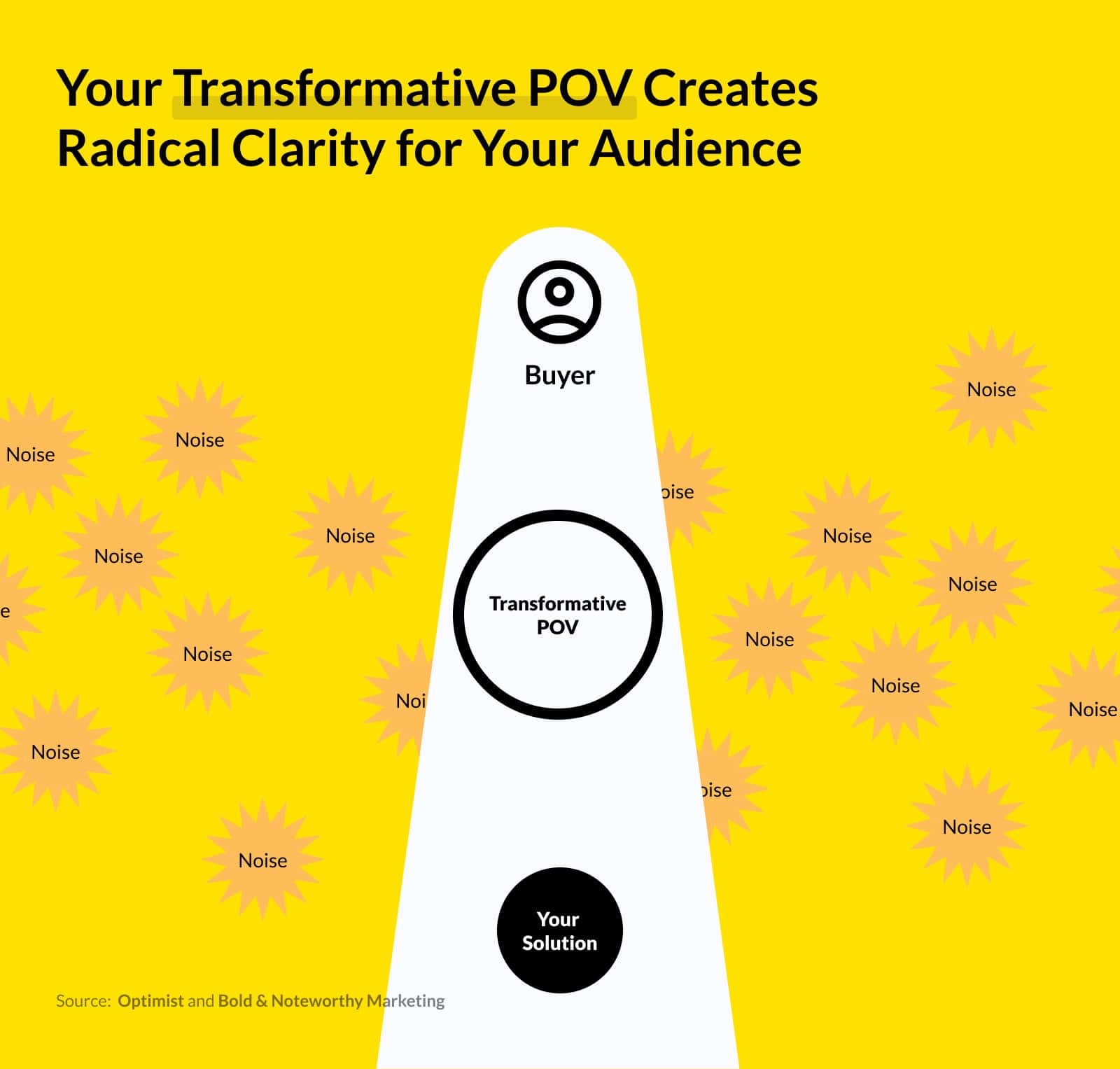
It’s that “aha” moment where they instantly recognize themselves in the story and finally understand the challenges they’re facing clearly. And they can see a clear path toward the solution — your solution.
Here are some of the questions to ask when crafting your Transformation Narrative:
- What’s the “old way” of solving your customers’ problem?
- What is the dominant conversation in the industry right now — and what is everyone not talking about?
- What trends or paradigm shifts are happening in your industry right now?
- How are they impacting your customers (and your business) and what are you doing about it?
- What’s the “new way” to solve your customers’ problem? And what’s the transformation after implementing the new way?
The output is a manifesto-esque mission statement. It should clearly articulate the “old way” vs. the “new way,” and lay the groundwork for your proprietary model, the solution that bridges these two realities.
You’ve just created the first piece of content in your Authority Moat.
Validate your POV against market dynamics, customer conversations, and data. Your goal is to align your internal thinking with the conversations happening in the market — and uncover any blind spots before you start investing in the foundational assets of your Authority Moat.
3. Construct & Deploy the Moat
With your Transformational Narrative in hand, you can now build your Authority Moat Plan.
This is the fun part. It’s where we get to take the ideas and themes we’ve just unearthed and imagine all the ways they can come to life across formats and channels.
Note that this is the opposite of how most content marketing is planned, where we choose channels and formats first and then try to figure out what content will fit inside the box.
Looking again at Basecamp’s content strategy: Nearly every piece of content they’ve created over the last 15 years has been grounded in their Transformative POV and Transformation Narrative. Blog posts, emails, books—the Rework podcast!
Fifteen years worth of content.
Do you think these guys ever have a “what should we write about” conversation?
Do you think they ever have to go around and around about why they can’t prioritize someone’s nephew’s cousin’s favorite TikTok meme as part of the content strategy?
Probably not. Because the content isn’t a series of tactics.
It’s a clear and cohesive strategy—driven and shaped by a single, unifying idea.
Here are the key ingredients you should build at this stage:
Authority Moat Content Plan
Three months of content ideas, mapped across the funnel. The goal is to pull through your Transformation Narrative at every single touchpoint of the customer journey.
Messaging Lenses
Use lenses to adapt messaging and positioning to address the problem you’re solving for different audiences, the state of the market landscape, and emerging trends. These will keep all your future content creation tightly aligned with your Transformation Narrative.
Validation Plan
KPIs and systems to test and refine your messaging in real time.
Now, it’s time to take your Authority Moat to market with a campaign centered around the highest-priority problem or audience segment. This is the first time you’ll plant your flag and start to see your brand’s perspective break through.
But it’s just the first step in a much larger strategy.
4. Expand & Multiply
A fully-formed Authority Moat includes a connected universe of assets derived from your Transformation Narrative.
Each Authority Moat content asset expands your competitive moat and defensible positioning within the market. You can also deploy each asset as a campaign, targeting a variety of audience segments or specific pain points.
By starting with a foundational idea to guide the content strategy, we can now build a universe of related assets that expand the reach and resonance of the message. Each asset builds on the others—compounding the effect and generating exponential impact over time.
Level 1: The Model
The foundation of your Authority Moat is a proprietary Model. It’s your differentiated worldview on how your audience should address their most pressing problems. This is what you develop when writing your Transformation Narrative.
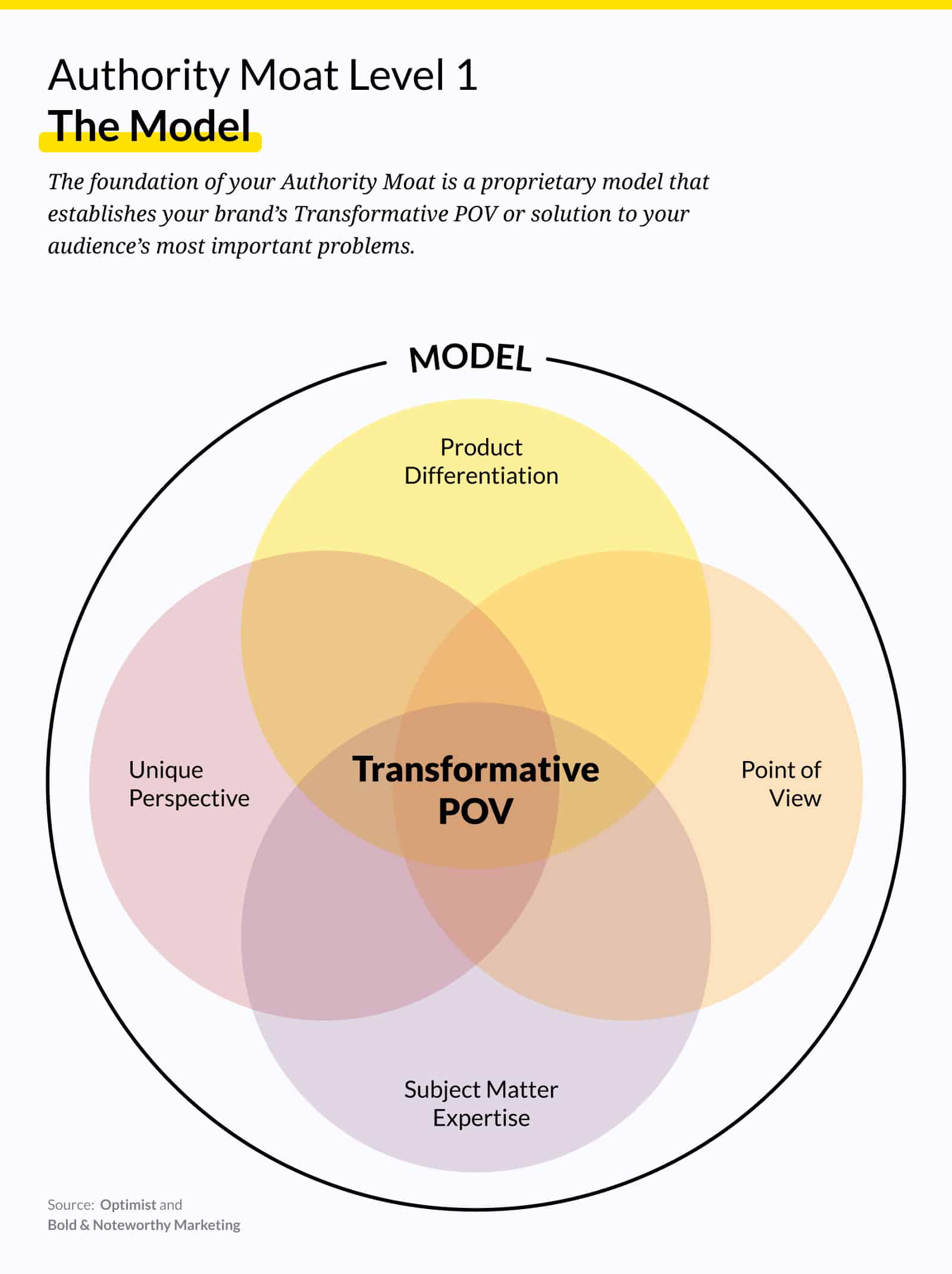
But it’s not a one-and-done tactic or a single content asset. It’s the starting point for building a strategic and cohesive constellation of content assets that establish and canonize your brand’s Transformative POV.
Level 2: Data & Process
With your Model in place, you can add additional assets that expand and support your Authority Moat.
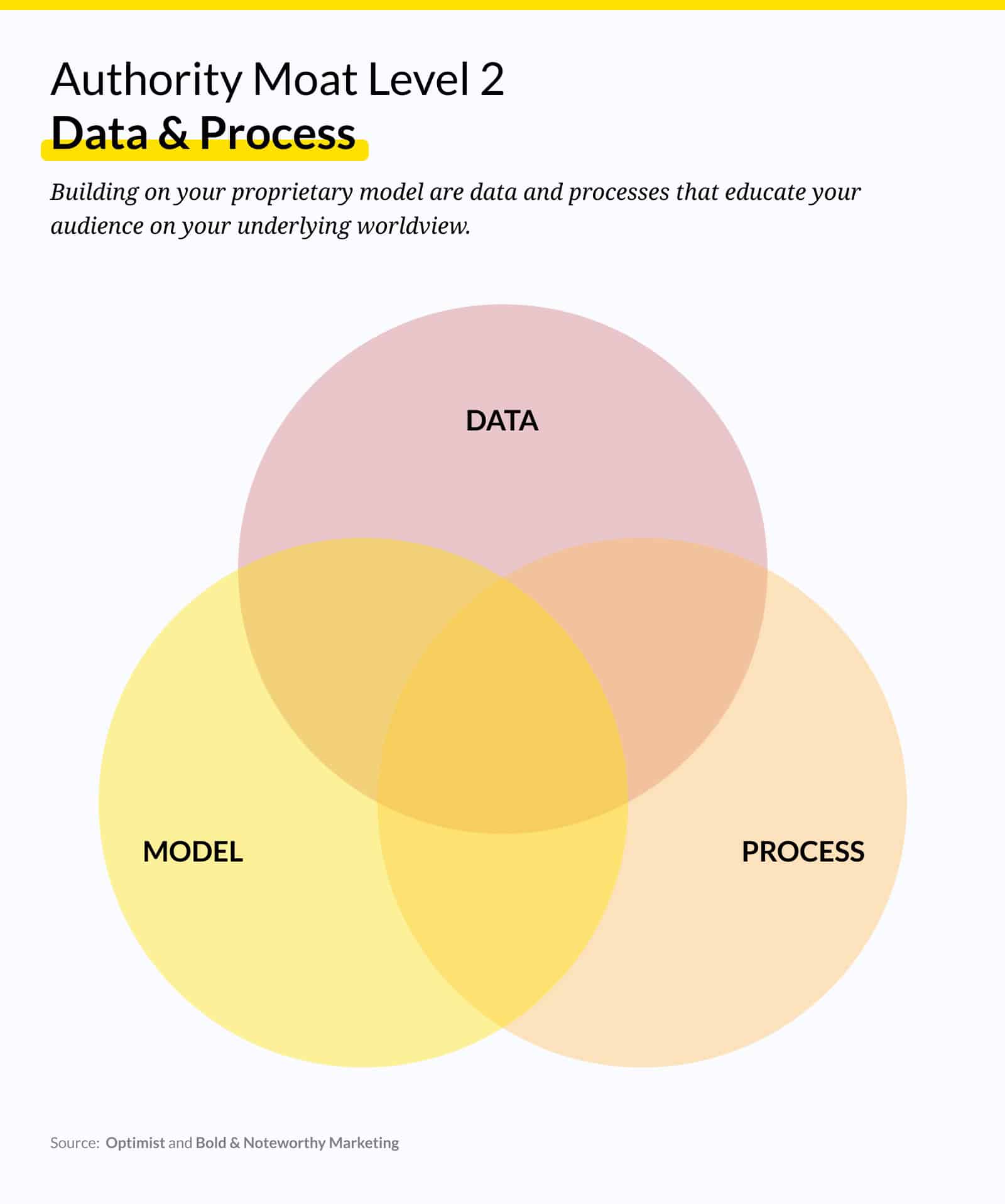
We categorize these assets in two main buckets:
- Data – Proprietary or secondary data that points to or validates your model.
- Process – Step-by-step systems for applying the model.
For example, you can run surveys or research reports that speak to the themes of your Transformation Narrative.
You can publish a guide that illustrates exactly what your new reality looks like in tactical and practical terms for your audience.
Level 3: Blending Assets
With two or more Authority Moat assets, you can begin combining them to form increasingly valuable and unique content.
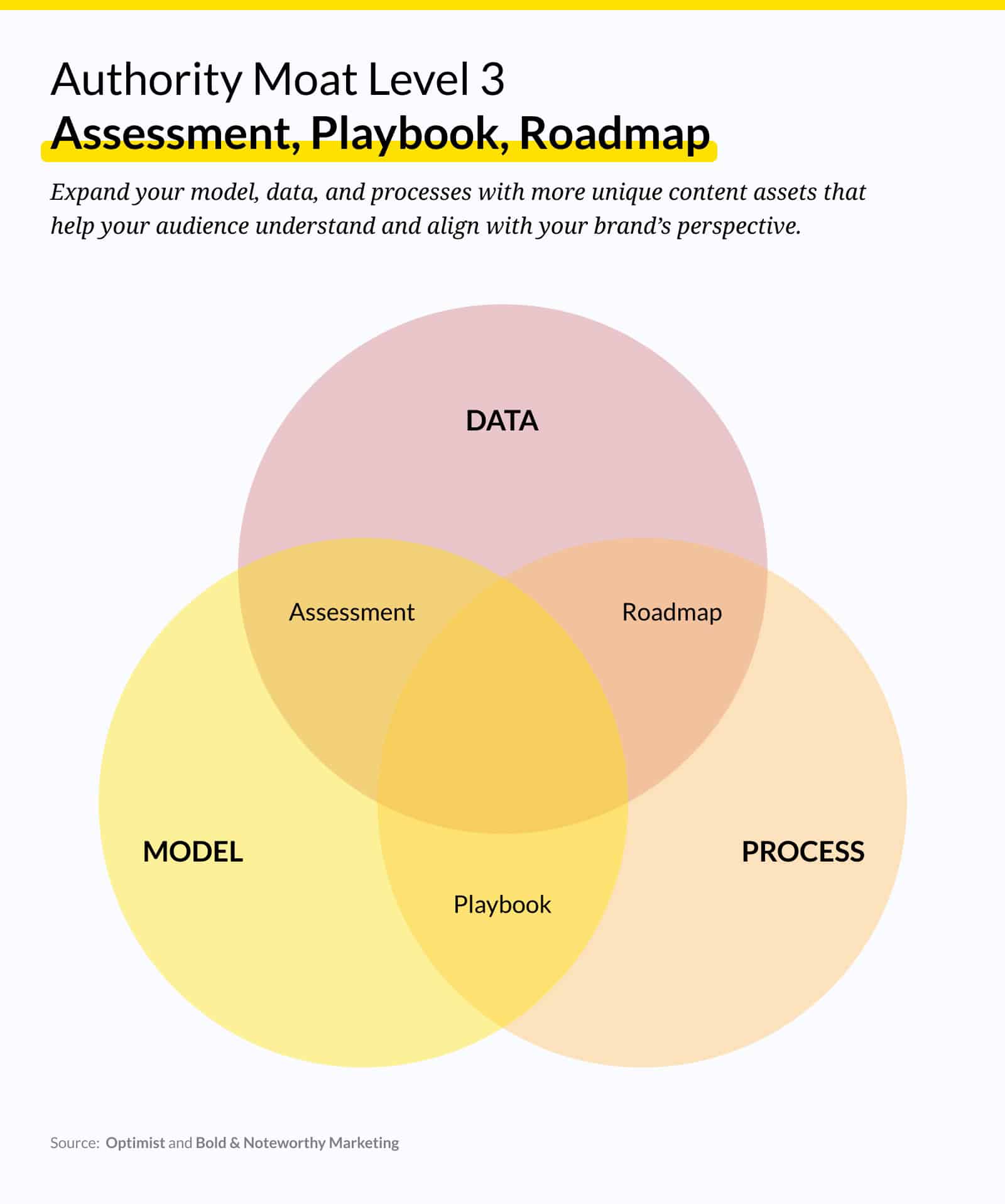
Level 3 assets include:
- Roadmap – Tactical action plan for moving from a current state to an ideal state, as defined by the model.
- Assessment – Relative scoring or ranking to measure progress toward application of the model.
- Playbook – Situational opportunities to deploy the model based on common pain points, alternative outcomes, or specific use cases.
At this stage, we’re also applying the Messaging Lenses that we developed as part of the initial plan.
For example, you can take your core Model — say Basecamp’s Rework again — and build targeted assets for creative agencies, tech startups, and manufacturers. You could even go a step further and create precisely-targeted content for specific buyers or stakeholders within each of those teams, like the CEO or the COO.
Each asset is still rooted in the same Transformative POV and Transformation Narrative. But it’s adapted to provide specific guidance and messaging for different audiences.
Once again, this is a radical departure from many content marketing strategies that treat each audience segment or ICP as a silo without much cohesion.
Level 4: The Universe
With all of these combined assets, you achieve a “Universe” — a unified constellation of supporting assets that give you full ownership over the underlying model and the concepts, ideas, data, processes, and systems within.
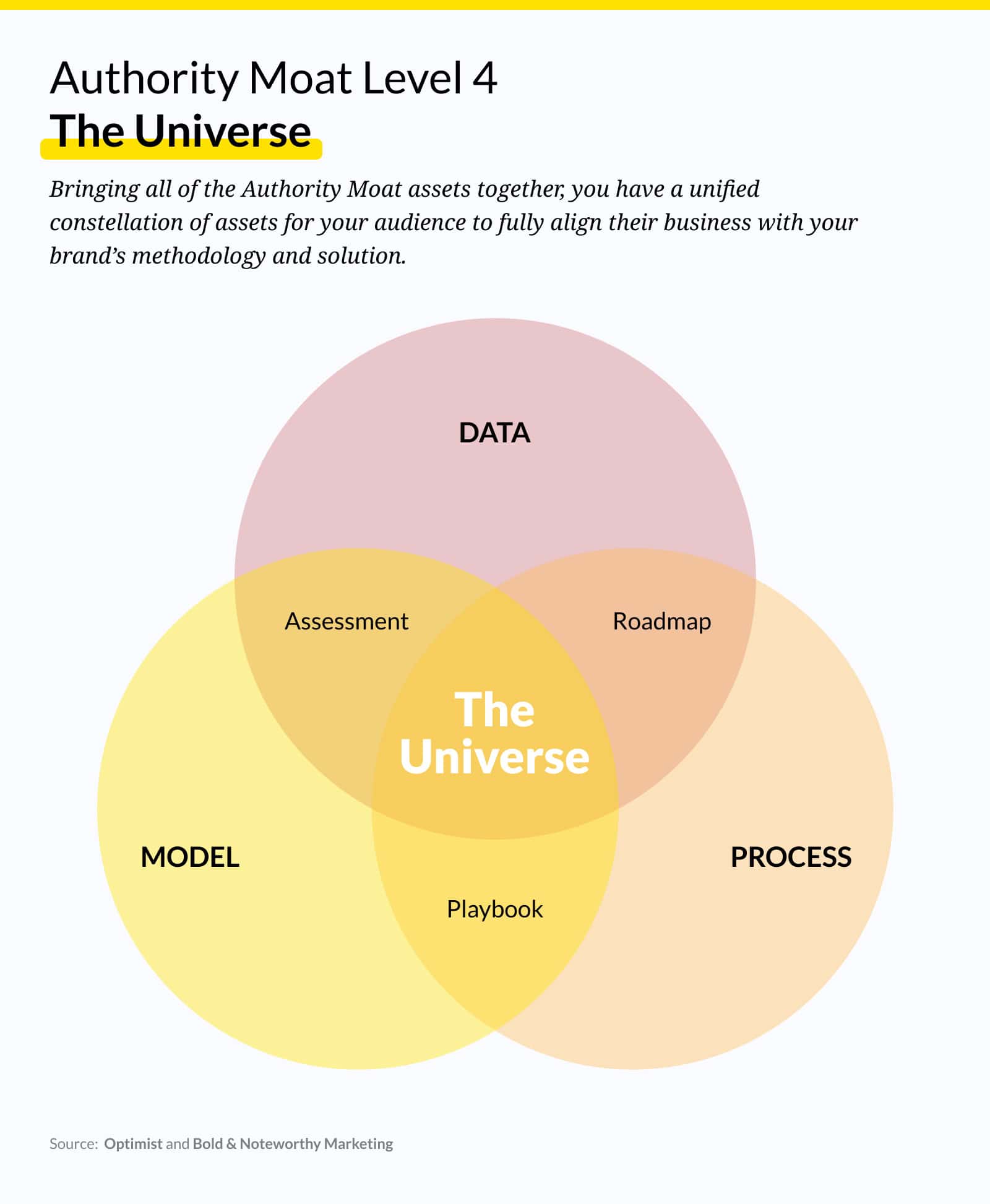
This is where you find the ultimate compounding value of The Authority Moat. =
The universe works together to move users through every stage of the customer journey. It builds an enduring and evolving strategy that unifies all of the content, marketing, and messaging across your organization. A consistent narrative that doesn’t waver when algorithms shift, channels change, or trends die.
But it’s not the end.
Brands can own and defend multiple narratives in the market. Just like Basecamp has launched both Rework and Shape Up (among other works), you can also multiply your Authority Moat by repeating the process with a new, differentiated POV.
How the Authority Moat Drives Outcomes
“We now face a choice:
- Scratch and claw to defend the old model, or
- Embrace the shift and redefine our role.
I’m choosing option 2.”
—Mark Rogers, Director of Content Marketing, Freshpaint12
The only way to cut through the avalanche of commodity content and reach and engage your audience is to build your Authority Moat.
This isn’t just about making great content. It’s a business imperative.
The Authority Moat paves the way for a fundamental transformation in how your business plans, creates, and deploys content in three dimensions.
Process Transformation
Transform the content process and how it sits within the org.
Go from order taker to a cross-functional and strategic architect & keeper of the narrative.
Your Authority Moat becomes the through line that ties every piece of content together. Your content team defines and shapes that narrative and collaborates with all teams for a distinct, cohesive message across every customer touchpoint.
Outcome Transformation
Replace scattered touch points and tactical content requests with a unified narrative throughout the customer journey.
This creates a cohesive and coherent experience and builds trust and momentum with buyers.
Watch users advance from an entry point to deep into your funnel with connected storytelling, framing their problem and leading to your solution the whole way. Product, marketing, and sales are all singing from the same songbook — and every conversation reinforces your own authority.
ROI Transformation
Content begins generating revenue from the very first touchpoint.
With content no longer a series of fragmented and tactical touch points, the value of content grows exponentially over time. The narrative compounds as each asset builds on the value and authority created by the existing library and forms the Universe.
A study from Bain & Company found that 90% of B2B buyers will choose a vendor from their day-one list13 – a company they already knew and liked before even investigating potential alternatives.
This only highlights what we already know to be true.
Building an authoritative brand will attract highly engaged prospects who align with your Transformative POV. They believe in your worldview. And they are much more likely to buy from you when they’re in the market for your solution.
But this only works if your content is part of a cohesive and consistent narrative.
With an Authority Moat (rather than generic, AI-flattened content), you retain your brand’s humanity, claim authority, inspire trust, and drive demand — all at the same time.
Many brands prove what happens when you stop feeding the Content Factory and build an Authority Moat instead.
Gong: A Blueprint for Emphatic, Insight-Led Content
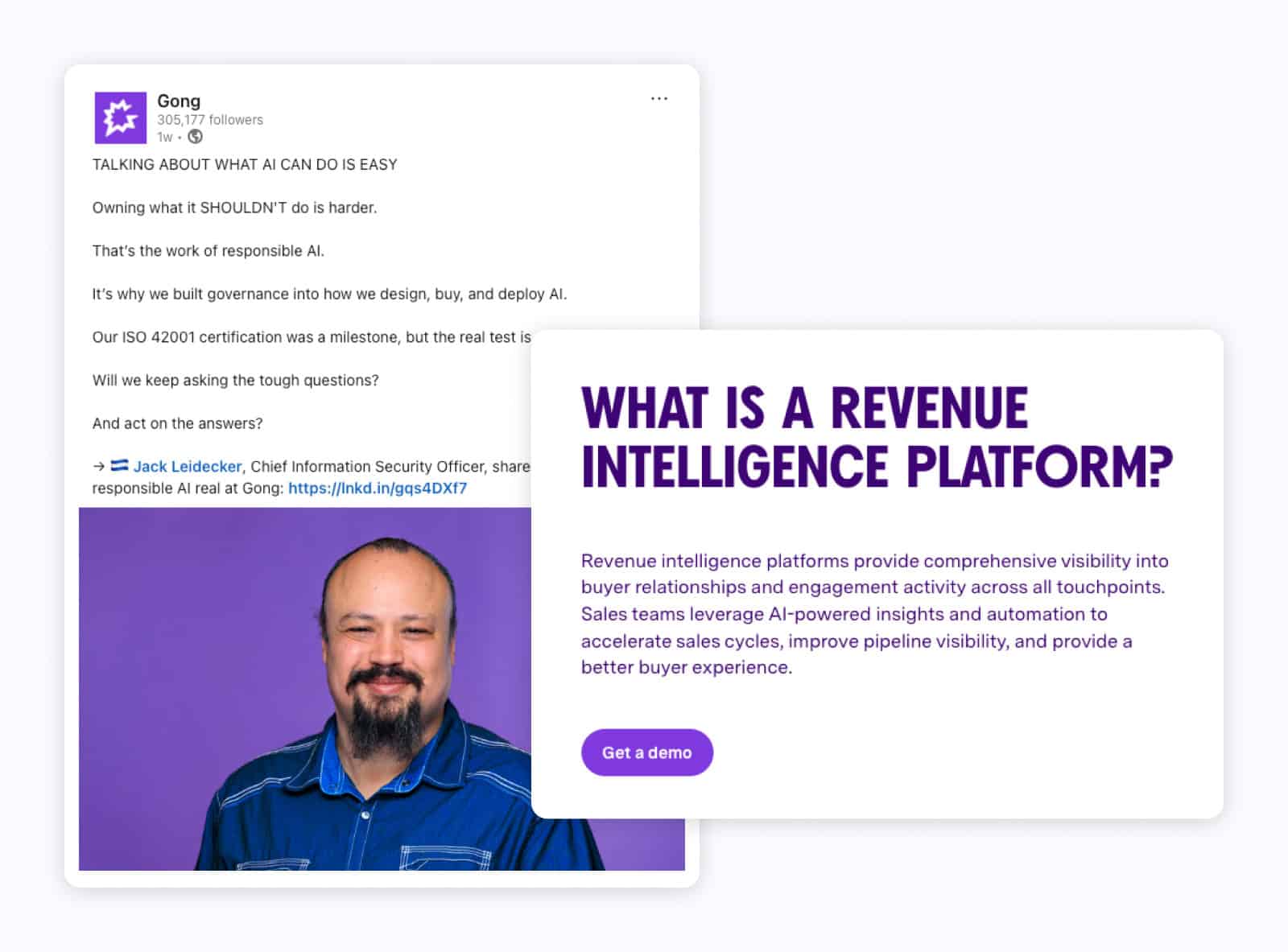
“Conversational intelligence” was a crowded category, and it didn’t resonate with decision makers. By redefining the space as “Revenue Intelligence,” Gong flipped the script: within 18 months, every competitor was using the term14, Forrester and Gartner had both issued reports on the category, and search volume went from zero to thousands each month.
But this wasn’t just a category play.
It was the narrative they created and put into the market, which fundamentally shifted buyer behavior and shaped buying decisions across their industry.
The result has been explosive growth in revenue, from $6 million in 2018 to an estimated $300 million in 202415.
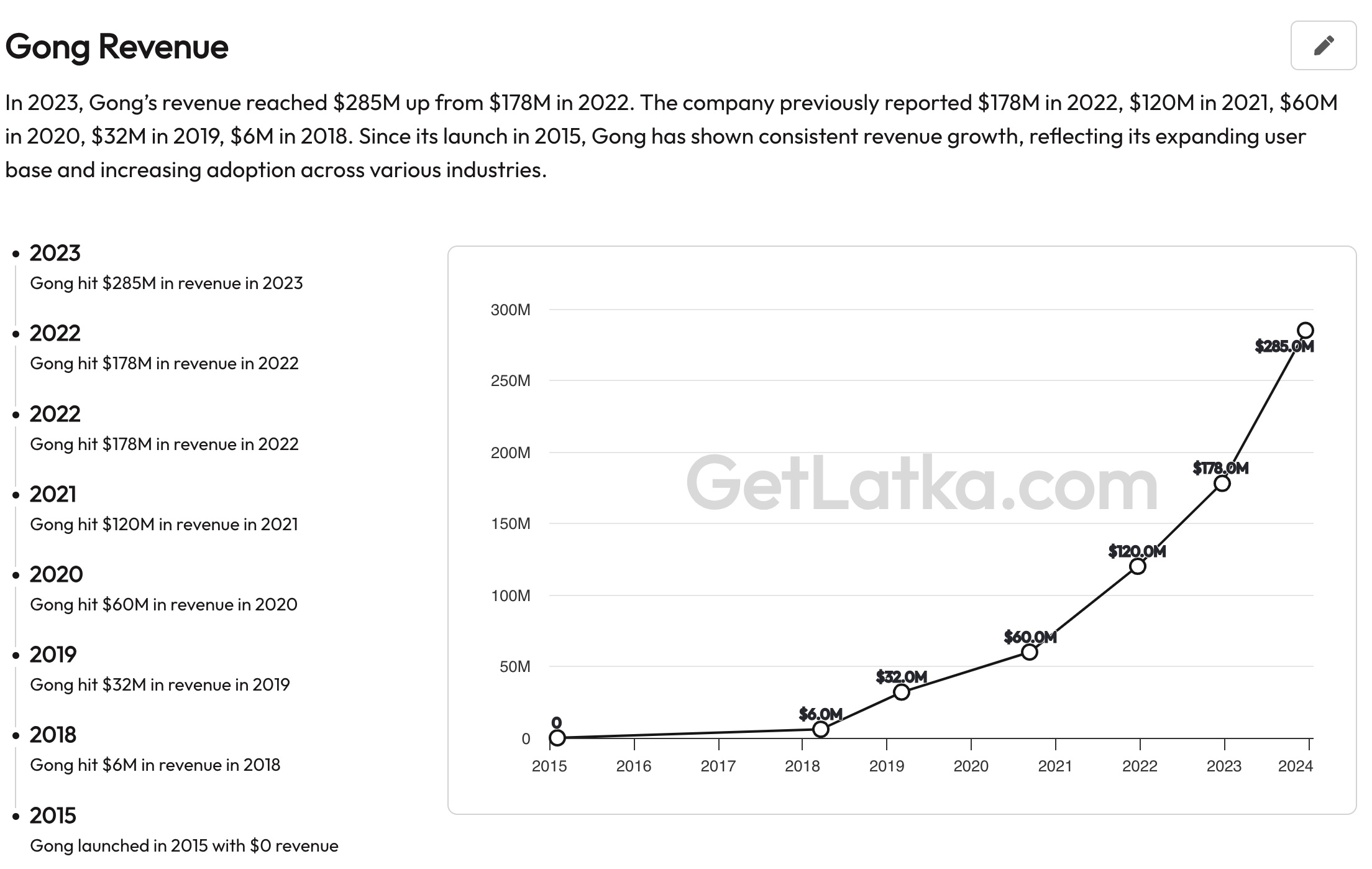
This growth didn’t just come from improved acquisition. Gong reportedly has a net revenue retention rate over 150%, meaning customers aren’t just loyal—they expand their relationship.
This is another huge upside of the Authority Moat Model. Since it’s built on consistent and differentiated messaging, you attract customers who align ideologically with your solution. They believe in the vision and they’re probably not feature shopping against competitors.
Key takeaways:
- Narrative ownership. By naming their solution “Revenue Intelligence,” Gong is controlling the conversation and forcing competitors to compete on their terms.
- Consistent drumbeat across channels. From website copy to a flagship content series called Gong Labs, full of original data-backed, proprietary research about the sales process, to partner content, every message supports their Transformation Narrative: Sales teams need end-to-end visibility that they can only achieve through an AI-powered Revenue Intelligence platform.
- Brand-persona alignment. The all-caps copy, the challenger tone, the bold neon graphics…Gong’s branding mirrors the urgency and competitiveness of their target audience.
Okta: Elevating Security for an Executive Audience
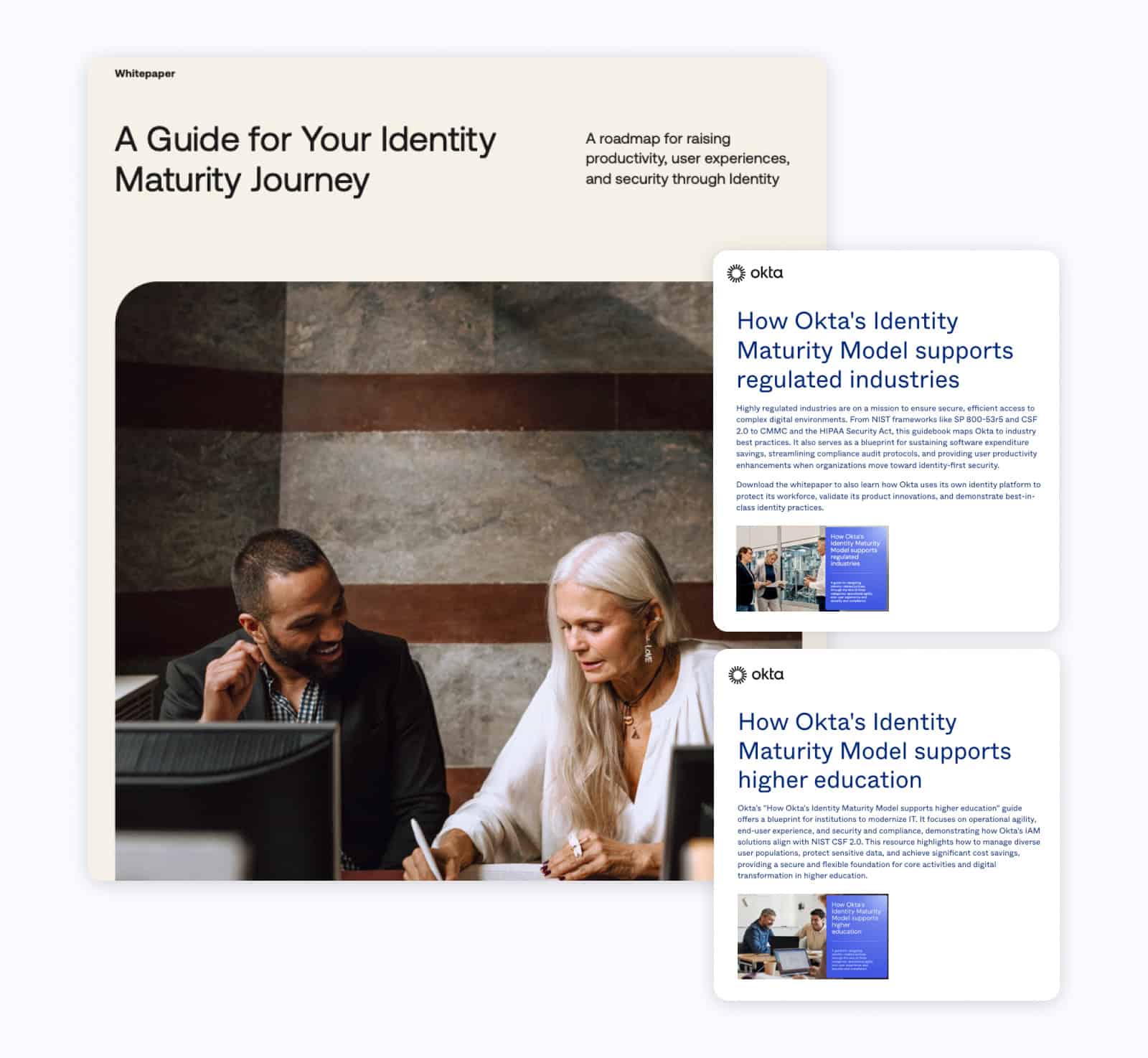
Lists of features don’t get the attention of C-suite decision-makers. That’s why Okta’s “Identity Maturity Model” repositions digital identity as a growth story. The message is clear: the more mature your digital identity strategy is, the more scalable and resilient your business becomes. Suddenly, security is a boardroom priority.
Key takeaways:
- Setting the terms of industry progress. By giving security leaders a model to benchmark themselves against, Okta leads the conversation.
- A model built to last. The Identity Maturity Model addresses customer needs at every stage of their growth, positioning Okta as a companion to businesses of every size.
- Spin-offs for multiple audience segments. Okta expands its Authority Moat with spin-off content for regulated industries, higher education, and more.
Getting Buy-In for a Bold New Content Strategy
The Authority Moat Model represents an exciting opportunity to elevate content leadership to a new strategic level and shift the role that content plays within teams.
And it’s a sorely needed shift as content teams face an untenable new reality:
- Most companies have seen a 25-30% drop in organic search traffic16
- AI traffic sources have only added back about 1% of traffic17
- 97% of all pages receive zero organic search traffic18
- 60–70% of B2B content goes unused19
In other words: Content has changed, and creating a higher volume of content will not overcome these deficits.
But it’s important to remember that this isn’t just an exercise in content supremacy.
Most importantly, The Authority Moat Model serves the needs of the business.
Data show how truly thought-leading ideas and perspectives help buyers navigate an increasingly chaotic and noisy world:
- B2B buyers consume an average of 13 pieces of content before making a purchase decision.9 If your content is forgettable, you are effectively excluded from their research.
- 75% of decision-makers and C-suite say that a piece of thought leadership led them to research a product or service they were not previously considering, according to an Edelman and LinkedIn study.20
- 90% of B2B buyers will ultimately choose a vendor from the day-one list of companies they already know and like13.
The power of the Authority Moat Model is uniting the entire company around a unified message that breaks through the noise, resonates with buyers at an emotional and logical level, and builds a competitive moat that creates compounding value. It achieves both brand and demand marketing goals by creating content that engages both the 95% of the market not ready to buy and the 5% who are10 with a consistent and cohesive narrative.
In an AI-first world, this is the greatest impact content leadership can have – keeping, crafting, and shaping the company-wide narrative to drive aligned and engaged prospects from the very first touch to the final signed contract.
But in order to operate up to your abilities, you have to escape the Content Factory once and for all and rally your stakeholders around a new vision for how content can drive business forward.
Let’s Make a Game Plan
Building your Authority Moat transforms content into your brand’s competitive differentiator — one that commands attention, cements trust, and fuels measurable growth.
But it’s not a solution that’s built in isolation. For The Authority Moat Model to work, you need a plan for engaging stakeholders, selling the vision, and rallying buy-in for a new narrative that will come to define your business in the market.
And we want to help.
Right now, we’re offering free, no-obligation Authority Moat Game Planning sessions.
In this 60-minute call, we’ll discuss your current content marketing strategy and operations, game plan a path to transforming the value of content within your org, and help you navigate the process of building internal alignment and executing The Authority Moat Model.
All you have to do is reach out.
Set up an Authority Moat Game Planning Session.
—
The Authority Moat Model was created by Kristen Rocco and Tyler Hakes. Kristen and Tyler partnered up to help marketing leaders evolve their content strategies for the new future of content marketing.

|
Kristen Rocco Fractional Content Marketing Leader of Bold & Noteworthy Marketing |

|
Tyler Hakes Principal & Strategy Director at Optimist |
Copywriting by Anita Isalska.
Design by Derrick Sun.
References
3. Google AI Overviews now show on 13% of searches: Study, May 6, 2025, SearchEngineLand
4. From Blueprint to Build: How to Operationalize Your Content Strategy, August 11, 2025, Relato Blog
6. The New Marketing Strategy I’ve Been Using For the Last 3 Months, Neil Patel, May 21, 2024
7. The State of Dis(Content), The Content Studio, October 2024
8. From Clicks to Connections: How Content Strategy is Redefining Engagement, iPullRank
10. 95-5 Rule, Ty Heath, Director, Market Engagement
12. Content marketers are boxed in, Mark Rogers, Director of Content Marketing at Freshpaint
13. What B2Bs Need to Know About Their Buyers, September 20, 2022, Harvard Business Review
14. Tofu AMA with Udi Ledergor, Chief Evangelist at Gong, September 19, 2023
15. 3 Key Strategies Behind Gong’s $285M Annual Recurring Revenue, September 23, 2025
16. How Google SGE will impact your traffic – and 3 SGE recovery case studies, September 5, 2023
18. 96.55% of Content Gets No Traffic From Google, Ahrefs, December 1, 2023
19. It’s Not Content – It’s a Lack of Buyer Insights That’s the Problem, Forrester